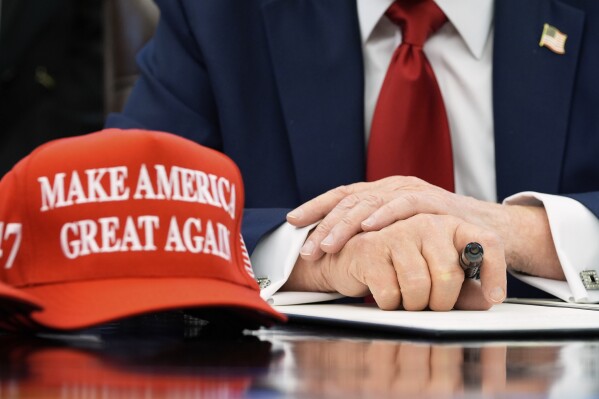How Trump Has Tried to Reshape America in His First 100 Days
The speed and scope of President Donald Trump’s efforts to redefine the relationship between the federal government and the American people during the first 100 days of his second term have been striking — a fact recognized by both his supporters and his critics.
As he visits politically symbolic Macomb County, Michigan, on Tuesday to mark this milestone, Trump will be able to highlight his aggressive and often unorthodox use of presidential power. He has pushed to downsize the federal workforce, restrict funding for both foreign and domestic aid, block illegal immigration at the southern border, promote cryptocurrency, and impose tough trade restrictions. He has also targeted independent institutions — including media outlets, universities, and law firms — that have challenged his agenda, while working to eliminate diversity initiatives within the federal government and its partner organizations.
Trump and his allies have repeatedly criticized federal judges who have issued rulings that impeded his policies. In one notable case involving immigration, his administration refused to comply with a court order to stop deportations under the Alien Enemies Act.
While past presidents have tested the boundaries of their constitutional authority during wartime or economic crisis — from Lincoln to FDR — none have attempted to wield such sweeping power across so many areas during a time of relative peace and economic calm. According to Princeton historian Julian Zelizer, Trump distinguishes himself by disregarding Congress and focusing on tearing down institutions rather than building them.

“We’ve had 100 days without a major piece of legislation,” Zelizer noted. “That’s the opposite of FDR’s approach, which was to pass as much legislation as possible. Trump’s strategy seems more intent on destruction than on creation. It’s hard to recall another president so disengaged from legislative accomplishment.”
Trump has also wielded presidential authority to reward allies and punish opponents, real or perceived, in a way that evokes the patronage politics of Andrew Jackson. His ongoing hints about seeking a third term — despite the constitutional two-term limit established in 1951 — have fueled concerns that he’s laying the groundwork to extend his hold on power beyond legal norms.
Steve Bannon, Trump’s former strategist and host of the “War Room” podcast, described Trump’s second term as transformative. “The Trump Project is a revolutionary project,” Bannon said via text. “He’s done more in 100 days to restore American greatness than any leader since Reagan.”
Macomb County, where Trump plans to speak, is historically known as the stronghold of the white working-class “Reagan Democrat” bloc. Trump has carried the county in all three of his presidential bids, and it remains a critical part of his political base.
However, despite his bold claims of a mandate to expand executive power, Trump has yet to tackle the central issue of the 2024 campaign — the economic hardship faced by millions. That inaction has dragged down his approval ratings.
A recent NBC News/SurveyMonkey poll found 55% of Americans disapprove of Trump’s job performance, with 45% approving. Pew Research Center reports his approval at 40%, down from 47% just two months ago — a slide attributed largely to dissatisfaction with his economic policies.
Pew also found that 49% of Americans believe Trump has weakened the economy, compared to only 37% who believe he has improved it. Confidence in his economic leadership has fallen even among Republicans, dropping from 92% to 80% in recent months.
Despite these concerns, the White House points to two key achievements: a significant drop in illegal border crossings and some progress on reducing inflation. Government data shows that illegal crossings through March totaled around 84,000, compared to over 555,000 during the same period last year. Inflation, though still high at 2.4% year-over-year, has slowed.
Yet many Americans remain unconvinced. Trump’s tariffs and aggressive economic moves have rattled markets and diminished confidence in the dollar. While inflation has eased — despite his promise to end it “on day one” — fears of financial instability persist. This raises serious questions about Trump’s effectiveness as an economic leader.
California Governor Gavin Newsom, a likely 2028 presidential contender, emphasized that Democrats should focus on the economic fallout of Trump’s policies. “We need to highlight how he’s damaged this economy,” Newsom said in a recent interview. “That’s the core issue. It’s what got him elected, and it’s where he’s let people down the most.”
Rep. Dan Goldman, D-N.Y., criticized Trump’s deep cuts to the federal workforce and domestic aid programs, calling them “an attack on working Americans.” Goldman, a former prosecutor who served as counsel to House Democrats during Trump’s first impeachment, warned that “the real threat is his systematic assault on the rule of law — especially his ongoing efforts to dismantle every form of accountability in our democracy.”
Trump’s rapid pace has led to some notable missteps, many tied to the newly created Department of Government Efficiency, led by billionaire Elon Musk. The department has faced backlash for attempting to shut down entire sectors of the federal government and lay off hundreds of thousands of public employees.
One high-profile blunder involved the dismissal of nuclear safety personnel, only for the administration to rush to rehire them amid security concerns. Trump has also walked back several key decisions, including his threats to impose new tariffs — which rattled financial markets — and his plan to oust Federal Reserve Chairman Jerome Powell, which he later abandoned.
Responding to concerns about the potential accidental deportation of U.S. citizens, White House Press Secretary Karoline Leavitt echoed a sentiment previously shared by President Trump in an interview with The Atlantic: mistakes are inevitable.
“As the president has said himself, nothing in this world is ever going to be perfect,” Leavitt said.
She reaffirmed the administration’s position that Trump has delivered significant progress on immigration and inflation. However, she acknowledged that the broader economy still requires work, placing the blame for current struggles squarely on the policies of President Biden.
“It takes time to undo the damage caused by those disastrous policies,” she said. “The full impact of the Trump economic boom won’t be realized until the pending tax cuts are signed into law.”
Looking ahead, Leavitt said Trump’s next 100 days will be centered around three major objectives: striking new trade deals, securing peace agreements, and finalizing a budget deal. Yet, progress on both trade and diplomacy has fallen short of campaign promises. Trump had pledged that peace between Russia and Ukraine would be reached by the time he returned to office — a goal that remains unmet. Likewise, his tariff strategy has yet to produce a landmark trade agreement with a major partner nation.
On the fiscal front, Republicans in Congress have been developing a “reconciliation” bill that would cut taxes and domestic spending, increase defense funding, and add significantly to the national debt.
Opposing or reshaping that legislation has become a rallying cause for progressive lawmakers, including Sen. Bernie Sanders, I-Vt., and Rep. Alexandria Ocasio-Cortez, D-N.Y. According to longtime Sanders adviser Faiz Shakir, they’ve been touring the country — particularly in Republican-held districts — to raise public awareness and pressure lawmakers.
“This budget plan, which cuts Medicaid and delivers tax breaks to the wealthy, could actually become a political opportunity for Democrats — if they stay focused,” Shakir said. “If you mobilize people around it, you could truly influence the outcome.”
Shakir argued that now is the critical time to challenge the legislation head-on, since GOP lawmakers may reconsider their stance when faced with potential political fallout.
“You organize and build public pressure while policy decisions are still being shaped,” he explained. “That’s how you lay the groundwork for real contrast going into the midterms. You can’t just show up at the end and say, ‘Vote for change.’ That doesn’t work.”

